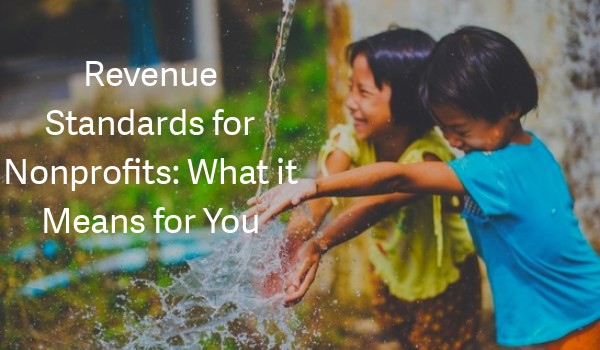5 Questions Nonprofits Are Asking About Revenue Recognition
Nonprofit revenue recognition compliance can be more complicated and involved than you might think. Is your nonprofit organization compliant? Are you ready for the new nonprofit revenue recognition standards?
1. What is the purpose of ASU 2018-08 and ASC 606
With ASC Topic 606, FASB seeks to bring US GAAP standards for revenue recognition into closer alignment with international standards (IRFS) so there can be greater clarity and consistency in treatment across nations, industries, and markets. ASU 2018-08 improves and clarifies the scope and existing prior guidance (from ASU 2014-09) around revenue from contributions.
Updates to revenue recognition standards represent the biggest changes in recent history in nonprofit accounting.
Nonprofit organizations with diverse revenue sources should reevaluate internal accounting processes in consideration of recent changes to revenue recognition from FASB. Both ASU 2018-08 and ASC Topic 606 bring a need to assess how nonprofit finance teams account for revenue and apply compliant practices, especially when organizations have a material deferred revenue amount outstanding at year-end.
2. Why are these changes so important?
The updated nonprofit revenue recognition standards impact revenue streams and require finance teams to apply greater judgment.
Some nonprofit organizations will find that the new revenue recognition standards greatly impact them while others may not notice as much change. For example, if you receive a lot of government grants, it’s important to note that grant payments may represent exchange transactions or contributions, depending on the details.
The new guidance helps standardize grant classification across different nonprofit sectors, such as colleges and universities, research institutions, and social service organizations—all organizations that tend to rely heavily on grants
and contracts.
Nonprofit finance teams really need to study and understand the updated standards, so they can apply the correct judgments about each revenue stream in their accounting and disclosures.
Refer to FASB Clarification & Guidance for more information.
3. How can I get my organization ready to comply with the new guidance?
The first step to compliance is to have conversations with leadership to make sure everyone understands how the financial statements may change as a result of applying the standards.
The process you should consider when implementing the new revenue recognition guidance is as follows:
- Study the guidance in its entirely
- Brief your leadership team and key stakeholders on potential impact to your organization
- Create a template for your analysis documentation
- Identify all of your revenue streams and related contracts
- Discuss the approach you will take with your auditors
- Do an analysis and document your conclusions
- Review your analysis and conclusions with your auditor
- Modify and document new policies and procedures
- Inform your leadership team and key stakeholders of the changes that will be implemented
- Re-evaluate the impact of the changes after implementation
4. What needs to be considered when grading revenue streams?
There are two things to consider when grading revenue streams – materiality and timing.
Materiality matters when it comes to grading revenue streams and being required to defer, so it should be the first thing you consider when deciding to apply revenue recognition guidance.
Once materiality is established, the second thing to consider is revenue timing. Revenue timing is relative to your year-end. If you receive and utilize the funds within the year, there is no need to worry about deferrals.
Follow these steps:
- Identify where your revenue comes from – what are your funding streams
- Look at you overall revenue stream and determine which ones are material
- If there is material, then consider the timing
- If it’s material and crosses over year-end, apply revenue recognition standards
- If it’s an exchange transaction, apply ASC Topic 606. If it’s not an exchange transaction, apply ASU 2018-08
5. Can I automate revenue recognition?
In the past, most nonprofit organizations painstakingly tracked revenue recognition by manually updating dozens of revenue schedule spreadsheets. We believe there’s a better way and recommend Sage Intacct.
Sage Intacct has released a nonprofit revenue recognition tool that works within Sage Intacct to automate the revenue recognition process.
Sage Intacct Revenue Recognition for Nonprofits centralizes revenue recognition inside the accounting system. You can track and account for non-exchange revenue like conditional grants and contributions as well as exchange revenue transactions like tuition in one central system. By combining the centralizing of information with Sage Intacct’s automated revenue recognition, you’ll improve visibility into conditions and restrictions and gain important insights about your organization’s revenue.

